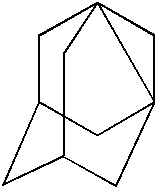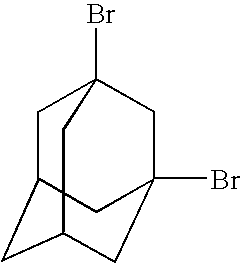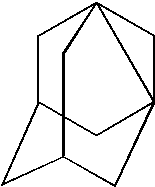Organo-silsesquioxane polymers for forming low-k dielectrics
a technology of organic silsesquioxane and dielectric, which is applied in the field of hybrid silsesquioxane polymers, can solve the problems of reliability failure, increased softness, brittleness and cracking, etc., and achieves excellent mechanical and thermal properties, improved dielectric constant performance of organosiloxane material compositions, and low dielectric constant
- Summary
- Abstract
- Description
- Claims
- Application Information
AI Technical Summary
Benefits of technology
Problems solved by technology
Method used
Image
Examples
example 1
Precursor Material
Adamantyltrichlorosilane C10H15SiCl3
Preparation Steps:
[0122]1. C10H16+2Br2→1,3-C10H14Br2+2HBr[0123]2. 1,3-C10H14Br2+2Li→C10H14+2LiBr[0124]3. C10H14+HSiCl3→C10H15SiCl3
[0125]106.4 g of (0.781 mol) adamantane C10H16 was added to a 2000 ml vessel followed by 500 ml dichloromethane. The solution was heated up to 40° C. and 92 ml (286.95 g, 1.80 mol) bromine was added to the vessel followed by a small amount of FeBr3 as catalyst. The solution was stirred at 40° C. for 15 hours.
[0126]Refluxing was stopped and solution washed with 500 ml of dilute HCl. A sodium thiosulfate solution was added to the vessel until the colour changed from red to brown. The organic layer was separated and evaporated to dryness. Crude 1,3-C10H14Br2 was dissolved in hot n-hexane and filtered. The filtrate was placed in a refrigerator and crystallized; the obtained, purified 1,3-C10H14Br2
[0127]
was filtered and dried in vacuum. Yield 192 g (84%).
[0128]58 g metallic lithium was added to a 2000 ml ...
example 2
Polymer Preparation
Material 1
[0141]Preparation of adamantysilanol intermediate. 7.0 g of adamantyltrichlorosilane (0.02595 mol) was dissolved in 56 ml acetone. The solution was transferred drop by drop into a solution containing acetone (70 ml), triethylamine (9.19 g, 0.0908 mol) and water (4.67 g, 0.2595 mol) within 20 min. During addition, the solution was vigorously mixed and the temperature of solution was maintained at room temperature (20° C., water bath). White precipitate was formed. After addition, the solution was mixed for an additional 20 hours at room temperature.
[0142]The solution was dried to dryness with a rotary evaporator (30° C., 200 mbar). 50 ml water was added and stirred for 10 min. After this, the solution was filtrated and the white powder obtained was flushed three times with 25 ml of water. The powder was dried under vacuum (40° C., 1 mbar), whereby 5.14 g of adamantylsilanol material was obtained that contained monomeric and oligomeric compounds.
[0143]Prep...
example 3
Polymer Material 1A—Alternative Method
[0147]Preparation of adamantylsilanol intermediate. Preparation of adamantylsilanol was made similarly as in Example 2, but tetrahydrofuran (THF) was used instead of acetone. Thus, 7.0 g of adamantyltrichlorosilane (0.02595 mol) was dissolved in 21 ml THF. The solution was transferred drop by drop into a solution containing THF (70 ml), triethylamine (9.19 g, 0.0908 mol), and water (4.67 g, 0.2595 mol) within 20 min. During addition, the solution was vigorously mixed and the temperature of the solution was maintained at room temperature (20° C., water bath). White precipitate was formed. After addition, the solution was mixed for a further 22 hours at room temperature.
[0148]The solution was dried to dryness with a rotary evaporator (35° C., 170 mbar). 50 ml water was added and stirred for 10 min. After this, the solution was filtrated and the obtained white powder was flushed three times with 25 ml of water. The powder was dried under vacuum (40...
PUM
| Property | Measurement | Unit |
|---|---|---|
| dielectric constant | aaaaa | aaaaa |
| dielectric constant | aaaaa | aaaaa |
| dielectric constant | aaaaa | aaaaa |
Abstract
Description
Claims
Application Information
 Login to View More
Login to View More - R&D
- Intellectual Property
- Life Sciences
- Materials
- Tech Scout
- Unparalleled Data Quality
- Higher Quality Content
- 60% Fewer Hallucinations
Browse by: Latest US Patents, China's latest patents, Technical Efficacy Thesaurus, Application Domain, Technology Topic, Popular Technical Reports.
© 2025 PatSnap. All rights reserved.Legal|Privacy policy|Modern Slavery Act Transparency Statement|Sitemap|About US| Contact US: help@patsnap.com



